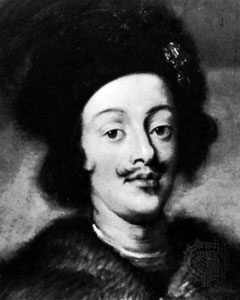Ferdinand III
Holy Roman emperor
born July 13, 1608, Graz, Inner Austria
died April 2, 1657, Vienna
 Holy Roman emperor who headed the so-called peace party at the Habsburg imperial court during the Thirty Years' War and ended that war in 1648 with the Peace of Westphalia.
Holy Roman emperor who headed the so-called peace party at the Habsburg imperial court during the Thirty Years' War and ended that war in 1648 with the Peace of Westphalia.The eldest son of the emperor Ferdinand II and Maria Anna of Bavaria, the energetic and able Ferdinand took part in ministerial councils and affairs of state from 1626. Archduke of Austria from 1621, he was crowned king of Hungary in 1625 and of Bohemia in 1627. Denied command of the imperial armies by Generalissimo Albrecht von Wallenstein, he took part in the conspiracy against the generalissimo and was partly responsible for his death in 1634. Thereafter, Ferdinand nominally commanded the Habsburg armies and in 1634 captured Regensburg and defeated the Swedes at the first Battle of Nördlingen in the same year. As leader of the peace party at the Austrian court, he encouraged negotiations leading to the Peace of Prague (May 1635), by which the emperor Ferdinand II tacitly abandoned his centralist and absolutist plans and restored the status quo of 1627.
Elected king of the Romans (heir to the imperial throne) in 1636, Ferdinand became emperor on his father's death the next year. Although he refused to allow religious freedom in his own domains and would not reinstate dispossessed Protestant nobility, he did not hesitate to compromise with Europe's Protestant powers and agreed to the Peace of Westphalia (Westphalia, Peace of), which ended 30 years of religious strife in central Europe and granted greater freedoms for Protestantism in Hungary. In internal affairs Ferdinand's creation of a standing army and his reform of the imperial council attest to his administrative ability. On his death his second son, Leopold I, succeeded him as emperor.
grand duke of Tuscany
born May 6, 1769, Florence
died June 18, 1824, Florence
grand duke of Tuscany whose moderate, enlightened rule distinguished him from other Italian princes of his time.
He became grand duke on July 21, 1790, when his father, Leopold II, succeeded as Holy Roman emperor. He continued the liberal reforms of his father and sought to maintain a neutral position toward the French Revolution. After he had established diplomatic relations with the French Republic (1793), however, he was constrained by England to join the coalition against France. Chased from his lands by the French in 1799, he took a command in the Austrian Army and soon returned to Florence. By the Treaty of Lunéville (Feb. 9, 1801), however, the French gained Tuscany; and, as compensation, he received the principality of Salzburg, with the title of elector. He later exchanged this principality for the duchy of Würzburg (Dec. 26, 1805) and joined the Confederation of the Rhine in 1806.
With the defeat of Napoleon, Ferdinand recovered Tuscany (1814) but shunned the reactionary violence associated with the restoration of princely power in Italy. Instead, he concentrated on the economic, social, and cultural redevelopment of his country. Having won the confidence of his people, he succeeded in maintaining a degree of independence from Austria.
king of Castile and Leon
also called Saint Ferdinand, Spanish San Fernando
born 1201?
died May 30, 1252, Sevilla; canonized February 4, 1671; feast day May 30
king of Castile from 1217 to 1252 and of Leon from 1230 to 1252 and conqueror of the Muslim cities of Córdoba (1236), Jaén (1246), and Sevilla (1248). During his campaigns, Murcia submitted to his son Alfonso (later Alfonso X), and the Muslim kingdom of Granada became his vassal.
Ferdinand was the son of Alfonso IX of Leon and Berenguela, daughter of Alfonso VIII of Castile. At birth, he was the heir to Leon, but his uncle, Henry I of Castile, died young, and his mother inherited the crown of Castile, which she conferred on him. His father, like many Leonese, opposed the union, and Ferdinand found himself at war with him. By his will Alfonso IX tried to disinherit his son, but the will was set aside, and Castile and Leon were permanently united in 1230.
Ferdinand married Beatrice of Swabia, daughter of the Holy Roman emperor, a title that Ferdinand's son Alfonso X was to claim. His conquest of Lower Andalusia was the result of the disintegration of the Almohad (Almohads) state. The Castilians and other conquerors occupied the cities, driving out the Muslims and taking over vast estates.
Ferdinand's second wife was Joan of Ponthieu, whom he married in 1237; their daughter Eleanor married the future Edward I of England in 1254. Ferdinand settled in Sevilla, where he is buried.
- arrangement
- Arran, James Hamilton, 1st earl of
- Arran, James Hamilton, 2nd earl of, Duc De Châtelherault
- Arran, James Hamilton, 3rd earl of
- Arran, James Stewart, earl of
- Arras
- Arras lace
- arrastra
- arrau
- Arrau, Claudio
- Arreola, Juan José
- arrest
- Arrest, Heinrich Louis d'
- Arrhenius equation
- Arrhenius, Svante August
- Arrhenius theory
- arrhythmia
- Arriaga, Juan Crisóstomo
- Arrian
- Ar- Rifāʿ
- Arrigo Boito
- Arrigo Caterino Davila
- Arron, Henck
- Arrow Cross Party
- arrowhead